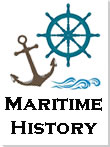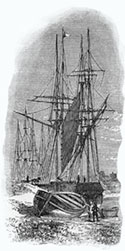Maritime History of Newport
By Peter Brown
© Peter Brown 2024
Custom Houses and officers
Customs refers to the centralised system for the collection of Customs duty (i.e., a levy on imported or exported goods), and from the 13th century, legislation required the placing of Customs officers in ports whose job was to collect all the duties due to the Crown in their designated areas.
HM Customs officers operated almost exclusively in and from the coastal ports of England and Wales (and later Scotland and Ireland). By the start of the 19th century, HM Customs had Custom Houses in 75 ports in England and Wales; each Custom House was staffed by a pair of Collectors, who received payments and supervised the other local officers who focused mainly on the examination of cargo, its assessment for duty, and the prevention of evasion (smuggling).[1]
While revenue collection and protection were the Customs officers' principal tasks, several other responsibilities were accrued to maritime law enforcement over the centuries. As the principal government representatives in England's (later Britain's) ports, Customs officers regulated salvage, quarantine, immigration, emigration, fisheries, trade and embargoes, and collecting statistics and other activities.
Officers:[2]
Collectors of Customs were appointed by Royal Patent to oversee the collection of duty.
Controllers/Comptrollers maintained a counter-roll (to exercise financial control) over the duty collection.
Customers (custodes custumae) were appointed in certain ports with overall responsibility for receiving and safeguarding money from the Collectors, ensuring its safe transfer from the ports to the City of London, and making payments locally when instructed to do so by the Exchequer.
Searchers were appointed in each port to arrest anyone dealing in counterfeit money, to examine all goods for import or export, and to ascertain that the correct duty had been paid. They focused on goods being loaded onto outbound ships for export: having checked the cargo against the ship's manifest, they would ensure that both the manifest and the cargo on board were tallied with the record of duties paid.
Surveyors were appointed to oversee several ports, where they supervised the work of the Searchers to ensure parity of practice across different locations. In each port, the Collectors, Controller and Searchers were required to render individual accounts to the Exchequer. There was a separation between the assessment of goods, revenue collection, and checking accounts.
Waiters were junior officers stationed in a port, and by the 17th century there was a distinction between Landwaiters, who had largely taken over from the Searchers the job of supervising the unloading of imported goods and then examining them, and Tidewaiters, tasked with boarding ships 'on the tide' before landing to ensure that no imported goods were unloaded prematurely. Tidewaiters were routinely required to remain on board until all cargo had been correctly discharged. Both were involved in checking for smuggled goods: the Landwaiters would provide the Tidewaiters with a list of all goods due to be discharged from their ship; at the quayside, each would monitor the transit of the goods listed (identified in advance by the Tidewaiters on board); then, after unloading, a check would be made that both lists tallied and the ship would be rummaged before being cleared to depart.
Tide Surveyors had oversight of the Tidewaiters, and also boarded “every ship from foreign parts” (along with the Tidewaiters) “to take an Account of them”; they would then continue to make regular visits to the vessel until all cargo was discharged, the vessel was cleared, and the Tidewaiters withdrew.
Watermen assisted the Tide Surveyors.
Watchmen were employed to guard ships at the quayside against the unlawful removal of cargo. Each Tide Surveyor was given a pinnace (a small boat, typically with sails and/or several oars) to undertake his duties.
Riding Officers were common during the 18th century around the coastlines of Britain. Their principal duty was to patrol the coast within their predefined riding range to suppress smuggling.[3]
Custom Houses
Newport collected various tolls and taxes as a market, trading town and port, and among these were Customs duties collected locally on behalf of the central government. This required the presence of Customs officers and a base for their operation, sometimes known as the tollhouse. In Newport, the tollhouse is believed to have been within the old west gate into the town, situated at the junction of High Street and the bottom of Stow Hill, where the various Westgate Hotels have stood.
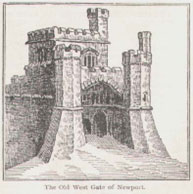
This stylistic and rather unlikely image is meant to show the old tollbooth at the west gate, but its origin is unknown.[4]
The Exchequer did not attempt to collect Customs duties in South Wales until the 1560s,[5] and we have no records of the Customs staff before the 16th century when we know that deputies were appointed by a Royal Commission for the creek of Newport.[6] These and later officers were presumably based in the West Gate tollbooth until it was demolished in the late 18th century.
In 1649, Mr Jo. Plumley and Mr John Rosser were the first named Customs officials. In 1701, the Customs staff consisted of “a waiter and a boatman in the yawl”, who cost £5 in the quarterly salary accounts[7] (a Waiter was employed to monitor vessels coming in and out of the ports, and a yawl was a small sailing boat). A further £5 was paid for the Waiter and Searcher, with “David Seys to be maintained in part with the Searcher’s ffees and from the king.” In 1737, the Deputy Customer called Thomas Williams was paid his salary plus a rent of 7s 6d per quarter for the Custom House “being his own house”.
The Customs books and accounts were sent from Newport to Cardiff and then to Bristol, where they were placed in the London Flying Waggon that sailed daily at noon with a guard.[8]
Some of the problems of managing Customs were illustrated in 1759 by Colonel Morgan, the MP, who possessed the Key (Quay) and Market Boat at Newport. He complained that the Comptroller at Newport had granted warrants to James Brown – the owner of the Eliza of Newport – to load goods at Peterstone Pill, about midway between Newport and Cardiff. As no officer was present and there was a local history of smuggling, action was taken to remove Brown’s permissions.[9]
As Newport exported coal during the 18th century, the duty payable needed to be calculated using official ‘coal bushels’ from London. In 1749, these were described as round and measuring 19½” across the top. The Collector and Comptroller were responsible for checking the records' accuracy so that everything was counted. The Newport measure had to be taken to Caerleon every time coal was loaded or discharged there.[10]
The rate book for the borough of Newport for 1795 tells us that David Jones was paid for his house and garden, and the Custom House adjoining valued at 15s. The building was one of four tenements on the Waterside, not far from the old Moderator warehouse, and held on a yearly rental of £2 10s. 0d.[11] Two houses were occupied by the Customs Boatmen, Richard Burton and James Dudley, and the third by David Jones, the Coastwaiter. A move in 1804 provided a single room only 12’ by 8’, at a rent of £10 per year.
By this time, the port was growing following the completion of the canal to the quayside in 1796, and in 1801 the staff comprised a Deputy Customer, a Deputy Controller, a Searcher, and three Boatmen. In 1810, Sir Charles Morgan offered to improve the facilities with space in his old Westgate Inn, which occupied the corner of Bridge Street and Stow Hill where the HSBC Bank now stands. This served as the Custom House until 1823, while Pillgwenlly was being developed and suitable premises could be built there for the shipping business of both Newport and Pillgwenlly.[12] The site of the old Westgate Inn became “the Corner shop” and was recorded as being within 50 yards, and in full view, of the quays. This confirms that Cinderhill Pill and Waterside Wharf must have reached near the top of Skinner Street.[13]
In 1818, a Watch House was built at the western extremity of the Hundred Acres Pill, at Pillgwenlly, which later gave its name to Watch House Parade. This stood near where the transporter bridge was built later and provided a base from where shipping entering the river towards the quays could be controlled. We know from a burglary in 1820 that the lost contents of the Watch House included “a spying glass, a pistol, a sweeping brush, a mop, a key of the boathouse, a bottle of whisky and a great coat.” The Boatmen who failed to man the post were dismissed from the service.[14]
In 1823, the occupation of the Custom House at the Westgate Inn was terminated, and for a period, official business was transferred to the house of Collector, Mr Marmaduke Brewer, in Skinner Street. Mr Brewer then increased the capacity by building premises adjoining his house in 1828. The building comprised: the Long Room for use by the First and Second Clerks, the Deputy Patentee of the Bill of Entry Office, and the Receiver of Lights and Merchant Seamen’s dues; two offices for the Collector and Comptroller; one office for the Searchers and Tide Surveyors; one office for the Locker, Tidewaiters and Boatmen; and one room where the Housekeeper (Mary Emanuel) lived.[15] The Queen’s Warehouse was situated next door.
When Newport was made an independent port in 1823, the Customs officials were: the Collector, Comptroller, Clerk, Tide Surveyor, Boatman, and Searcher (Edward Frost, the first cousin of John Frost).
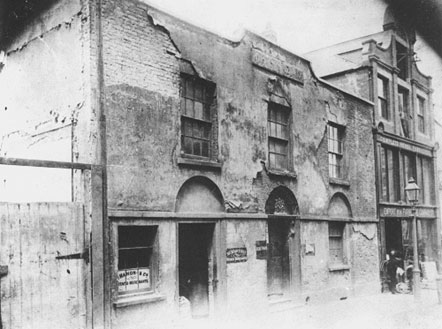
The old Custom House in Skinner Street. The building on the right survives as William Hill’s bookmakers.
In the Act of Parliament (1835) relating to the construction of the Town Dock, there is provision for constructing a stone road from a point opposite the Custom House on Llanarth Street. The stone road was probably Canal Parade, and this Custom House was possibly one of two tenements occupied between 1794 and 1810 and perhaps still in use. Official records clearly show that in 1835, the Custom House was in Skinner Street and was used for port business from 1828-58.[16] The site was at 9 Skinner Street, occupied in 1932 by Spencer’s Stores and recently by MVR Solutions.
By 1847, the situation at the Watch House became inconvenient for hailing and boarding vessels due to tram roads, coal yards and jetty heads recently erected by the Tredegar Wharf Company between it and the river bank.[17] Arrangements were then made in 1851 by the Company to build a new Watch House threequarters of a mile lower down the river, in an isolated spot with fields where the North Dock was later built. When the North Dock opened in 1875, the Watch House became the property of the Alexandra Dock Company but was still used by Customs staff for many years.
The provision of a new Custom House became urgent by 1856, and two sites were considered. The choice was between an area adjoining the later Masonic Hall in Lower Dock Street and Ruperra Street, and a site in Dock Street near the Town Dock where the eventual Custom House still stands. It opened on 2 March 1858, and the staff then were: a Collector; First Clerk; Second Clerk; Third Clerk; First Surveyor, Landing and Coastwaiter; Second Surveyor, Landing and Coastwaiter; First Tide Surveyor; Second Tide Surveyor, Assistant Tide Surveyor; Locker; and 11 Tidewaiters and Boatmen. Other officials were classified as Glutmen and Preferential Glutmen, who appear to have been Messengers/Watchmen attached to the Custom House.[18] With the growth of shipping, the staff number increased in later years.
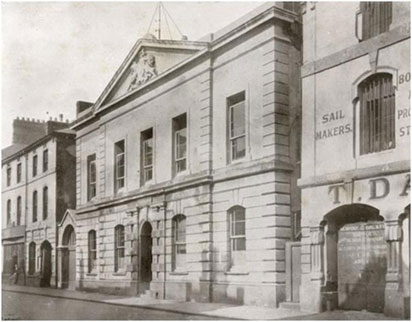
The Custom House in Dock Street, opened in 1858.
Following the completion of the extension to the Town Dock in 1858, another Watch House was built at the head and first used in 1870. It was still in service as a hailing station and Waterguard Office for all upriver traffic in 1932. The Watch House on the lock side of the North Dock continued in use until 1912, when it reverted to the Docks Company on the occupation of the new premises for the Waterguard at the South Dock. A boarding station was later added – with office and boat slip – at the New Lock to the South Dock Extension.[19]
From 1851 to 1882, the Collector and his staff carried out the Mercantile Marine duties for the Board of Trade. This work increased proportionately to the port commerce, and in 1875, accommodation was so limited that additional rooms were built onto the Custom House.[20] In 1851, the number of seamen engaged and discharged was 2,158; in 1874, 6,691 in 833 crews. Hundreds of letters were sent, and money orders were written and paid. Two Mercantile Marine Police Officers were also based there.
The old Mercantile Marine Offices were illuminated by gas, which was not installed in the Long Room and other Customs offices until 1881, and as a cost-saving measure, candles had to be used before that time. Records refer to “…twelve double sliding candlesticks with shades and snuffers and a supply of composite candles”.[21]
The Board of Trade eventually took separate offices and conducted their own work, while the merger of HM Customs and HM Excise in 1909 brought new work into the building.[22]
References
1 https://en.wikipedia.org/wiki/HM_Customs
2 https://en.wikipedia.org/wiki/HM_Customs ; Platt (2007/2011) Smuggling in the British Isles: A History, 110-111.
3 https://en.wikipedia.org/wiki/Riding_officer
4 http://www.newportpast.com/gallery/prints/westgate.htm
5 Jones, Evan T. and Stone, Richard (2018) The World of the Newport Medieval Ship: Trade, Politics and Shipping in the Mid-Fifteenth Century, 83.
6 Dawson, J. W. (1932) Commerce and Customs: A History of the Ports of Newport and Caerleon, 118.
Online at: https://archive.org/details/commerce-and-customs-newport
7 Dawson, 118.
8 Dawson, 43.
9 Dawson, 44.
10 Dawson, 43.
11 Dawson, 120.
12 Dawson, 120.
13 Dawson, 121.
14 Dawson, 122.
15 Dawson, 122.
16 Dawson, 125.
17 Dawson, 124.
18 http://www.customscowes.co.uk/a_to_f.htm
19 Dawson, 127.
20 Dawson, 127-9.
21 Dawson, 128.
22 Dawson, 128.
Back to Index of Peter Brown's "Maritime History of Newport "
